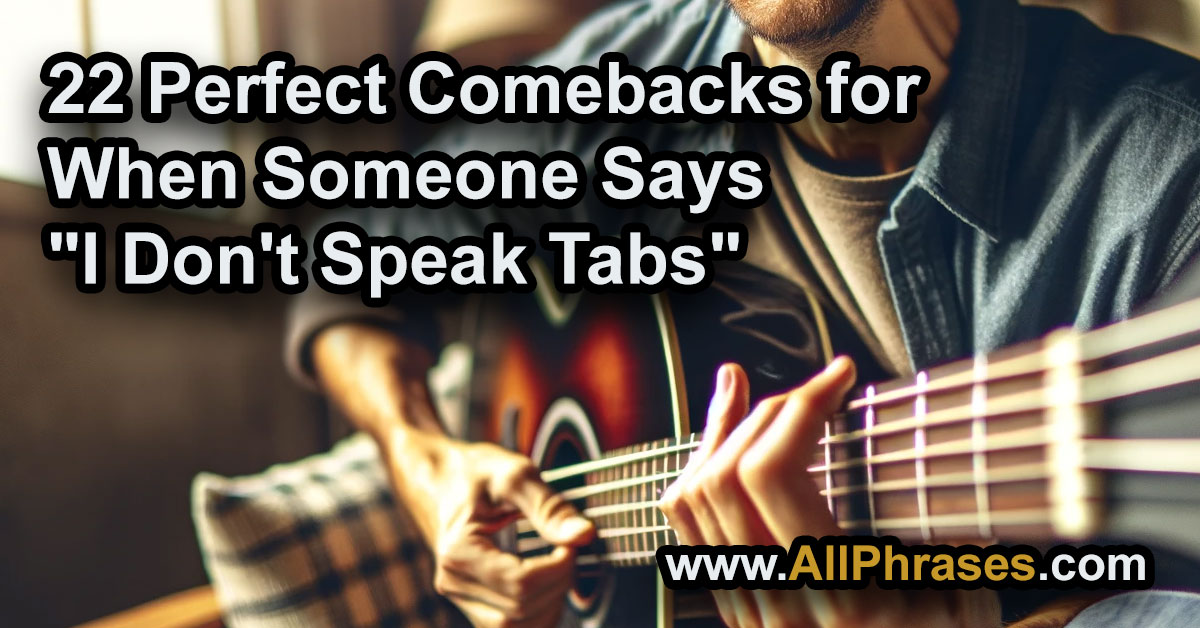Ever been in a jam session and someone shrugs off your guitar tab with a breezy “I don’t speak tabs”?
It’s a moment that can throw any guitarist off their groove. But don’t fret!
We’ve strummed up 22 snappy comebacks that will keep the music flowing and maybe even teach a thing or two about the art of guitar tabs.
Next time you’re met with that all-too-familiar phrase, you’ll have the perfect chord to strike back.
Let’s amp up your comeback game and keep those guitar vibes positive and rocking!
#1 – “Then let’s talk in chords!”
- This quip suggests transitioning the conversation from guitar tabs to chords. It’s a light-hearted way to emphasize that music has various forms of language and that chords are a more universally understood element in guitar playing.
#2 – “No worries, I’m fluent in riffs.”
- This response humorously implies that the speaker can communicate through guitar riffs instead of tabs. Riffs are memorable and often a key part of a song, making this a clever way to continue the musical conversation.
#3 – “I guess it’s time for a free-form jam then!”
- This comeback proposes an impromptu jam session. It’s a fun suggestion that music can be a spontaneous and creative expression, not reliant on any specific form of notation like tabs.
#4 – “But do you understand the language of licks?”
- By mentioning guitar licks, this reply playfully challenges the person to communicate through these short, expressive musical phrases, which are a staple in guitar playing.
#5 – “Let’s switch to sheet music, then!”
- This response jokingly suggests moving to a more formal type of musical notation. It’s a witty way to acknowledge different music reading skills.
#6 – “In that case, let’s speak through solos.”
- Proposing a guitar solo as a means of communication, this comeback highlights the expressive and individualistic nature of guitar playing.
#7 – “I’ll be your tab translator!”
- This friendly offer suggests that the speaker can help interpret or translate tabs, showing willingness to assist in understanding guitar tablature.
#8 – “Ever tried the universal language of groove?”
- This reply emphasizes the concept of ‘groove’ in music, implying that rhythm and feel are more important than any specific musical notation.
#9 – “How about we communicate with capos?”
- Mentioning capos, this response playfully suggests using these devices to change the guitar’s pitch as a form of non-verbal communication.

#10 – “Time to tune into the melody, then.”
- This comeback focuses on the melody of a song, suggesting that understanding and communicating through melodies can be as effective as using tabs.
#11 – “Let’s have a chat with chord progressions.”
- Here, the idea is to use chord progressions as a means of musical conversation, emphasizing the foundational role they play in guitar music.
#12 – “I guess you’re more of a strumming linguist.”
- This quip lightly teases that the person might be better at strumming, a basic guitar technique, as opposed to reading tabs.
#13 – “Let’s let the rhythm talk.”
- Suggesting that rhythm can be a means of communication, this response highlights the importance of rhythmic patterns in guitar playing.
#14 – “Shall we converse in fingerstyle?”
- This comeback proposes using fingerstyle guitar playing, a technique involving plucking the strings directly with fingertips, as a form of musical dialogue.
#15 – “Time to decode the music by ear, then!”
- This suggestion promotes the idea of learning and understanding music by ear, a skill highly valued among musicians, especially when tabs are not an option.
#16 – “Let’s turn up the amp and let the tone do the talking.”
- By focusing on the guitar tone, this response implies that the sound quality and character of the guitar can convey as much as any tablature.
#17 – “I’ll express it in harmonics instead.”
- This reply proposes using harmonics, a technique producing a unique sound on the guitar, as a way to communicate musically.
#18 – “How about a tutorial in dynamics?”
- Suggesting a lesson in dynamics (the variation in loudness), this comeback implies that musical expression goes beyond just reading tabs and includes understanding the emotional intensity of playing.
#19 – “Let’s sync up with syncopation.”
- This witty response suggests using syncopation, a rhythmic technique, as a means of musical communication, emphasizing the importance of rhythm.
#20 – “Time for an improvisation session!”
- This comeback encourages an impromptu playing session, highlighting the importance of creativity and spontaneity in music.
#21 – “Let’s break it down with a beat.”
- Proposing to use a beat as the basis for communication, this response emphasizes the role of rhythm and timing in guitar playing.
#22 – “How about we just feel the music?”
- This suggestion implies that sometimes feeling the music and getting into its groove is more important than any technical knowledge of tabs or notation.
In wrapping up our musical journey through clever comebacks and guitar wisdom, it’s clear that the world of guitar playing is as versatile and expressive as the players themselves.
From the rhythmic strumming of chords to the intricate dance of fingerstyle, each response we’ve explored offers a unique way to keep the conversation – and the music – flowing
As guitarists, we may not always ‘speak’ in tabs, but our shared language of melodies, riffs, and grooves transcends any single method of communication.
The next time you’re faced with “I don’t speak tabs,” you’ll have a repertoire of witty retorts to keep the tunes rolling and the smiles growing.

